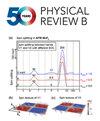Full minimal coupling Maxwell-TDDFT: An ab initio framework for light-matter interaction beyond the dipole approximation
IF 3.7
2区 物理与天体物理
Q1 Physics and Astronomy
引用次数: 0
Abstract
We report an , nonrelativistic QED method that couples light and matter self-consistently beyond the electric dipole approximation and without multipolar truncations. This method is based on an extension of the Maxwell-Pauli-Kohn-Sham approach to a full minimal coupling Hamiltonian, where the space- and time-dependent vector potential is coupled to the matter system, and its back reaction to the radiated fields is generated by the full current density. The implementation in the open-source code is designed for massively parallel multiscale simulations considering different grid spacings for the Maxwell and matter subsystems. Here, we show applications of this framework to simulate renormalized Cherenkov radiation of an electronic wave packet, magneto-optical effects with nonchiral light in nonchiral molecular systems, and renormalized plasmonic modes in a nanoplasmonic dimer. We show that in some cases, the beyond-dipole effects cannot be captured by a multipolar expansion Hamiltonian in the length gauge. Finally, we discuss further opportunities enabled by the framework in the field of twisted light and orbital angular momentum, inelastic light scattering, and strong-field physics.求助全文
约1分钟内获得全文
求助全文
来源期刊

Physical Review B
物理-物理:凝聚态物理
CiteScore
6.70
自引率
32.40%
发文量
0
审稿时长
3.0 months
期刊介绍:
Physical Review B (PRB) is the world’s largest dedicated physics journal, publishing approximately 100 new, high-quality papers each week. The most highly cited journal in condensed matter physics, PRB provides outstanding depth and breadth of coverage, combined with unrivaled context and background for ongoing research by scientists worldwide.
PRB covers the full range of condensed matter, materials physics, and related subfields, including:
-Structure and phase transitions
-Ferroelectrics and multiferroics
-Disordered systems and alloys
-Magnetism
-Superconductivity
-Electronic structure, photonics, and metamaterials
-Semiconductors and mesoscopic systems
-Surfaces, nanoscience, and two-dimensional materials
-Topological states of matter
 求助内容:
求助内容: 应助结果提醒方式:
应助结果提醒方式:


